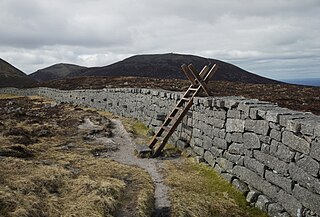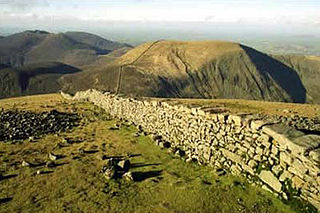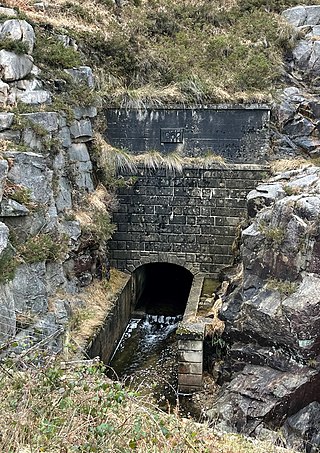
Newcastle is a small seaside resort town in County Down, Northern Ireland, which had a population of 7,672 at the 2011 Census. It lies by the Irish Sea at the foot of Slieve Donard, the highest of the Mourne Mountains. Newcastle is known for its sandy beach, forests, and mountains. The town lies within the Newry, Mourne and Down District.

Ladybower Reservoir is a large Y-shaped, artificial reservoir, the lowest of three in the Upper Derwent Valley in Derbyshire, England. The River Ashop flows into the reservoir from the west; the River Derwent flows south, initially through Howden Reservoir, then Derwent Reservoir, and finally through Ladybower Reservoir. The reservoir is owned by Severn Trent.

The Mourne Mountains, also called the Mournes or Mountains of Mourne, are a granite mountain range in County Down in the south-east of Northern Ireland. They include the highest mountains in Northern Ireland, the highest of which is Slieve Donard at 850 m (2,790 ft). The Mournes are designated an Area of Outstanding Natural Beauty and it has been proposed to make the area Northern Ireland's first national park. The area is partly owned by the National Trust and sees many visitors every year. The Mourne Wall crosses fifteen of the summits and was built to enclose the catchment basin of the Silent Valley and Ben Crom reservoirs.

Carryduff is a small town and townland in County Down, Northern Ireland, about 10 kilometres (6.2 mi) south of Belfast city centre. It had a population of 6,961 people in the 2011 Census.

Annalong is a seaside village in County Down, Northern Ireland at the foot of the Mourne Mountains. Annalong is in the civil parish of Kilkeel, the barony of Mourne, and the Newry and Mourne District Council area. It had a population of 1,805 at the 2011 Census. The village formerly exported dressed granite and is now a fishing and holiday resort.
The Shoalhaven Scheme is a dual-purpose water supply and Pumped-storage Hydroelectricity scheme located on the South Coast region of New South Wales, Australia.

Slieve Binnian is one of the Mourne Mountains in County Down, Northern Ireland, 9 km north of Kilkeel. It is the third-highest mountain in Northern Ireland at 747 metres (2,451 ft). The summit is broad and flat with rocky tors at the north and south ends, with the Back Castles, impressive towers of granite, in between. To the south-west is Wee Binnian (460m). It lies east of Silent Valley Reservoir and west of the Annalong Valley. The Mourne Wall also crosses over Slieve Binnian.
Events during the year 1952 in Northern Ireland.

Baitings Reservoir is a large water supply reservoir operated by Yorkshire Water close to Ripponden in the West Yorkshire Pennines, England. It lies in the valley of the River Ryburn and is the higher of two reservoirs built to supply Wakefield with water and was completed in 1956. The lower reservoir is Ryburn Reservoir.

Spelga Reservoir is a reservoir in the townland of Spelga in the Mourne Mountains of County Down, Northern Ireland. It was formed by the Spelga Dam and sits at over 1,200 ft (370 m) above sea level. It has a volume of 2,700,000 cubic metres and a catchment area of 5.423 km². It occupies an area known as Deers Meadow, and impounds the River Bann, which rises on the nearby Slieve Muck.

Rivelin Dams are a pair of water storage reservoirs situated in the upper part of the Rivelin Valley, 5 miles (8 km) west of Sheffield in South Yorkshire, England. The dams are owned by Yorkshire Water and provide water to 319,000 people as well as compensation water for the River Rivelin. They are named Upper and Lower and fall just within the eastern boundary of the Peak District.

Luke Livingstone Macassey was an Irish civil engineer and barrister, notable for his contributions to public health by improving the water supply in the north of Ireland. In 1874 he was appointed consultant hydraulic engineer by the Belfast Water Commissioners in which capacity he was instrumental in finding new sources of water for the expanding city of Belfast. He proposed use of a 9,000-acre catchment area in the Mourne Mountains and a three stage project:
- The first stage was to divert water from the Kilkeel and Annalong rivers through the newly constructed Mourne Conduit to a reservoir at Carryduff. These water pipes were capable of supplying 10 million imperial gallons of water per day. Work was completed in 1901.
- The second stage was to build a storage reservoir, the Silent Valley Reservoir, across the Kilkeel River. Design work on this phase began in 1910, but procurement of the work was delayed by World War I. A contract was eventually awarded in 1923 to S. Pearson & Son and work continued until 1933.
- The third stage was planned to be another storage reservoir in Annalong to impound the Annalong River. However, after the difficulties encountered in building the Silent Valley dam this second dam was not built.

Ben Crom is a 526 metres (1,726 ft) mountain in the Mourne Mountains in County Down, Northern Ireland. It is situated beside Ben Crom Reservoir, which is upstream from Silent Valley Reservoir. The mountain is composed of granite. An exposed area on the south west of the mountain shows where the Eocene aplitic granite meets the laccolith top of the older Mesozoic granite ring dike. The summit of the mountain features granite crags which are crossed by basic and feldspar porphyry dikes. The mountain is used for sheep grazing and hill walking.

Ben Crom Reservoir is a reservoir located in the Mourne Mountains near Kilkeel, County Down, Northern Ireland. Along with Silent Valley Reservoir, which is situated further down the Kilkeel River valley, it supplies water for County Down, surrounding counties and most of Belfast. It was constructed between 1953 and 1957, as the final part of the Mourne scheme to provide water to Belfast which started with the passing of the Belfast Water Act in 1893.

Annalong Forest is located near the village of Annalong in County Down, Northern Ireland. It is made up of two sections: Annalong Wood and Silent Valley. The forest consists of various species of conifer. It is part of the Mourne Area of Outstanding Natural Beauty. There have been two major forest fires in the area since 2011. One, which started on 30 April 2011, required 10 fire engines to extinguish and caused the temporary closure of several roads. Another, on 24 April 2010, destroyed approximately 50 hectares of gorse and was believed to have been started deliberately.

The Belfast Water Commissioners was a public body in Ireland and later Northern Ireland, established by the Belfast Water Act 1840, to improve the supply of water to the expanding city of Belfast. By 1852, the city was suffering a shortfall in supply of almost one million gallons per day. In 1889 the body's name was changed to Belfast City and District Water Commissioners in recognition of the expanding boundaries of Belfast and resulting increased demand for water.
The Mourne Conduit was a water main which ran 42 kilometres (26 mi) from the Silent Valley Reservoir to Carryduff, near Belfast and was built between 1893 and 1901 for the Belfast City and District Water Commissioners. This was supplemented by additional pipelines twice in the 20th Century. This system supplied water to Greater Belfast and North Down for more than 100 years. It is labelled as the Mourne Aqueduct in Ordnance Survey maps from the early 20th century.

Slieve Lamagan or Slievelamagan is one of the Mourne Mountains in County Down, Northern Ireland. It has a height of 702.2 metres (2,304 ft). Slieve Lamagan stands in the middle of the high Eastern Mournes, overlooking Ben Crom Reservoir to the west, Annalong River valley to the east, and Cove Mountain to the northeast. At its southern foot is a small lake called Blue Lough, and a rock formation known as 'Percy Bysshe'.



















